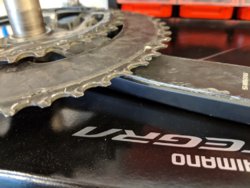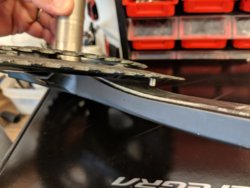Both the FC-5800 and FC-R7000 cranks are touted as having both technologies, and from the seams in the spider look to be of the same construction as the Ultegra and DA cranks. I wonder why there have been far fewer (if any) reported failures with these lower-spec models..?Don't confuse 'Hollowtech' crank design/manufacture with Hollowtech 2 axle and BB 'technology'/Shimano standard. On the same crankset but two discreet design aspects.
You are using an out of date browser. It may not display this or other websites correctly.
You should upgrade or use an alternative browser.
You should upgrade or use an alternative browser.
Page may contain affiliate links. Please see terms for details.
Drago
Legendary Member
- Location
- Suburban Poshshire
Don't be too disappointed. Properly executed, bonding is stronger than welding, even stronger than the material itself.Interesting observation. Certainly looks like it's a problem with the bonding; being a luddite I was a bit disappointed to see that this much-touted "Hollowtech" format relies on bits being glued together.
I’ve got the 105 5800 version of that Ultegra crank that failed and it looks identical, however the 105 series is slightly heavier so perhaps it’s just a bit more robust.
Proto
Legendary Member
- Location
- East Devon/West Dorset
It happened to a mate of mine two weeks ago. Not sure if mileage, but low I think, possibly less than 5k. He’s in touch with Madison looking for resolution.


I am not sure why the knowledgeable guy in the video has not come across many examples in Northern Europe, I have heard of quite a few, both on forums and in real life. The problem with a warranty claim or even an out of warranty good will gesture is that it can take months to resolve.
I saw this video on YT today - the chap who does it is an aerospace engineer and he puts out some very informative videos and thus far I've had no reason to doubt his reasoning. It would be interesting to see @Yellow Saddle 's viewpoint on this one.
View: https://www.youtube.com/watch?v=Rj__lexd_BI
Thanks - a pretty insightful video IMO

It seems that the argument for failure beginning due to corrosion at the joint in the spider holds the most weight; since any moisture sealed inside the assembly will be a function of the place it was manufactured; not where it's being used (which seems to be a significant factor).
My first thought regarding the voids was to dry them thoroughly and fill them with some sort of sealant / corrosion inhibitor; however if this is hydrocarbon based I think there's also the danger of it degrading the adhesive in that area and causing a similar failure; albeit through a different mechanism.
Bugger! I agree about the heavier build of the 105 cranks, but if we'r talking adhesive failure due to (presumably) the action of oxidation of the crank material forcing the two parts of the crank apart, I can't see how the thicker walls assumed from the 105's heavier construction would make any difference.I’ve got the 105 5800 version of that Ultegra crank that failed and it looks identical, however the 105 series is slightly heavier so perhaps it’s just a bit more robust.
Another angle might be material choice - perhaps the Ultegra and DA cranks are made of a different grade of ally that's perhaps stronger (to allow thinner, lighter construction) but also more prone to corrosion...?
I'm still taking some comfort from the Instagram feed mentioned in the video, since of all the images of failed cranks it contains there are no 105s pictured, so they must be less prone to failure if not immune as your example has proven. Don't suppose you still have it? In light of all this it'd be interesting to take a closer look!
alvintc
Veteran
- Location
- West Sussex
Drago
Legendary Member
- Location
- Suburban Poshshire
Holy Mary mother of Trump! As a good an advert as any for the proper pre-ride checks that so many riders seem to pooh-pooh...until it happens to them.
Yellow Saddle
Guru
- Location
- Loch side.
Some interesting pictures here. It would be useful if they could be correlated to batch numbers or failing that, years of production.
A note on "bonding". Can we please just call it glue? Don't "cold set" the terminology.
A note on "bonding". Can we please just call it glue? Don't "cold set" the terminology.
... and when not properly executed it leads to situations like thisDon't be too disappointed. Properly executed, bonding is stronger than welding, even stronger than the material itself.

Ahh, sorry - I mis-read your post and thought yours had failed. If not that certainly bodes well for those running 105Pointless checking mine, it’s only done about 100 miles, it was only fitted recently

Last edited:



